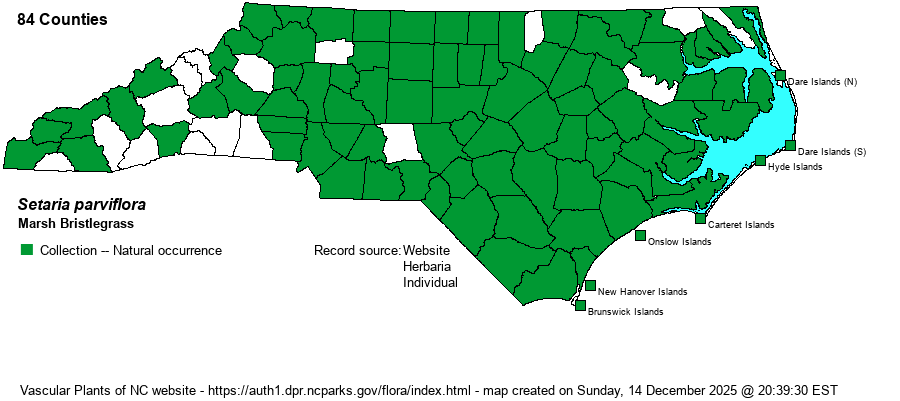| Author | (Poiret) Kerguelen | |
| Distribution | Throughout the state, including the Outer Banks and barrier islands. Probably occurs in every county.
MA to IA, south to FL and TX; disjunct to CA and NV. W.I., Mex., C.A. | |
| Abundance | Frequent to common throughout except in the Mountains, where fairly common. | |
| Habitat | Meadows, fresh to brackish marshes, maritime wet grasslands, wet interdune depressions, roadside ditches, low fields, damp disturbed areas. | |
| Phenology | Flowering and fruiting late May-October. | |
| Identification | The inflorescence of this common species looks ghostly due to the pale straw color of the bristles, almost whitish in color. The bristles are numerous (4-9 per spikelet) compared with 1-3 bristles per spikelet in Coastal Bristlegrass (S. corrugata). Like that species, the height of the stems is about 1-2 feet tall. | |
| Taxonomic Comments | In older texts often treated as S. geniculata.
The inflorescences of bristlegrasses look like bottlebrushes, due to the numerous bristles that stick out sideways or that angle upward. Two of our 3 native species are annuals; S. parviflora is perennial. When using keys, make sure to have mature fruiting plants and a dissecting scope to see such features as the surface texture on lemmas, number of bristles per spikelet, etc. | |
| Other Common Name(s) | Knotroot Bristlegrass, Bristly Foxtail, Knotroot Foxtail | |
| State Rank | S5 | |
| Global Rank | G5 | |
| State Status | | |
| US Status | | |
| USACE-agcp | FACW link |
| USACE-emp | FAC link |

